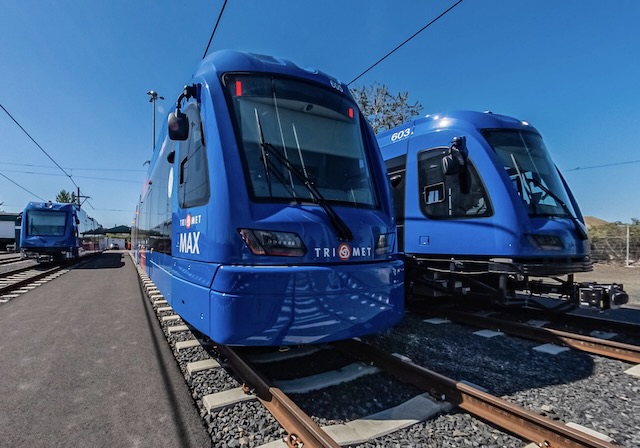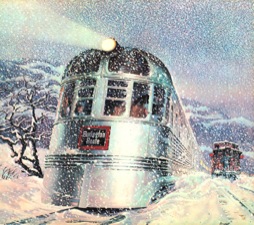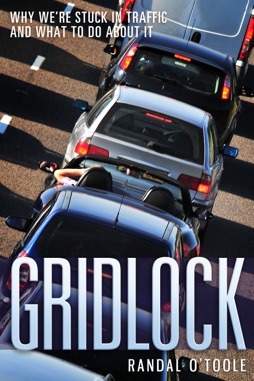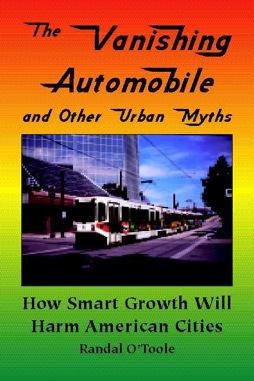Portland’s transit agency, TriMet, is introducing new “technologically advanced” light-rail trains to its system. Yet most of these “technological advancements” seem pretty lame to me. Among other things, the new cars have “Better temperature control for heating to keep trains warm in cold weather.” Is this an admission that past light-rail cars from the same builder were too hot in summer and too cold in winter?
The new cars also carry 168 people. That’s hardly a major “technological advance” over the previous cars, which carried 172 people. However, TriMet’s original light-rail cars, which the new ones will be replacing, only carried 164 people. They achieved this incredible technological advance by making the new cars four feet longer. Portland has the shortest city blocks in the country, and since light-rail trains can’t be longer than a city block, TriMet operates the lowest-capacity light-rail system in the country, yet it still calls its light rail “high capacity transit.”
The new cars can be operated from both ends. That’s also true of all other TriMet light-rail cars purchased between 1984 and 2004, but a few cars purchased since 2008 had cabs only at one end, which meant they had to operate in pairs even if there was no demand for that much travel. These are the cars that have room for 172 people because the extra 8 people could sit where the cab would otherwise be. So fixing TriMet’s idiotic decision to make cars that can only move in one direction unless they are connected to another car is considered a “technological advance.”
Another great technological advance is that the doors on the cars will have lights to tell riders whether they are open or closed just in case riders couldn’t tell from the fact that the doors were, you know, open or closed. I don’t know how most Portlanders managed to get along before such lights were installed. Oh, that’s right: most Portlanders never ride transit.
The new cars will also have “improved on-board cameras with clearer pictures” and “wireless downloading.” I’m sure the knowledge that videos can be wirelessly downloaded will be very comforting to people when they get stabbed to death or otherwise just stabbed on board the trains.
TriMet’s latest light-rail cars will have destination signs inside, something that many other rail systems have had for years. Finally, the railcar headlights will be LEDs, which were first available on automobiles 21 years ago.
TriMet doesn’t disclose how much it paid for these technological wonders, but other agencies have typically paid about $4 million apiece for this model. That’s enough to buy six or eight buses that together could carry at least twice as many people as each light-rail car. Rail cars last longer than buses (probably because they are more expensive and thus better maintained), but still end up costing more per seat/standing room-mile, and that’s before counting the cost of the rail line itself.
The advantage of buses is that, since they are smaller and not bound to a few miles of track, they can go more frequently to more destinations than Portland’s light-rail cars. While the buses would each require a driver, they don’t require continuous track maintenance, which more than offsets the cost of drivers.
Of course, all of the claims about technological advances are really just hype to make up for the fact that light rail is really an early twentieth-century technology. Streetcars, of course, date back to the 1880s, and the only real difference between light rail and streetcars is that light-rail cars can be coupled together in trains (though only trains of two cars in TriMet’s case). Light-rail cars also tend to be longer than streetcars and bend in the middle to go around sharp corners. The first light-rail cars that fit this description date back to 1937 when the Oakland Key System acquired cars for carrying people across the new San Francisco-Oakland Bay Bridge.
The problem with light-rail trains is that they only go where the rails go. Those rails are expensive to build and expensive to maintain, and for the most part don’t go where most people want to go. Particularly in Portland, with its two-car trains, light rail is a failed technology that should be replaced with buses as existing lines wear out.









So, before he blocked me pointing out his silliness
sam_d_1995
https://x.com/sam_d_1995/status/1881510081801629935
emphasized NYC did indeed spend Millions of dollars and Years of research to publish 4000 pages a MILE of paperwork to analyze Congestion pricing….and he’s bragging about it.
Years and millions in taxpayers money and 4000 pages wording all to illustrate the NYC subway is financially irreparable without having to kick in subsidies derived from car drivers… If the densest city in USA with most comprehensive rail transit system cant financially recoup sufficient money to pay it’s upkeep… why should auto drivers who don’t use it at all.
Can’t…resist…
While SpaceX put more than 300 rockets into orbit for less than $10 billion, California has built 1,600 feet of elevated rail for $11 billion, and now projects its high speed rail project will cost a total of $128 billion.
NEW PIECE from Palantir CTO Shyam Sankar on Pirate Wires: Trump will get America out of “manager mode”